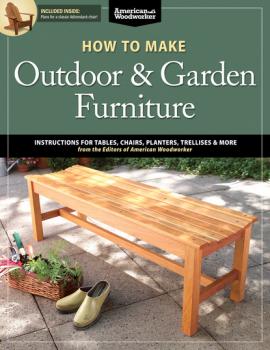ТОП просматриваемых книг сайта:
Дом и Семья: прочее
Различные книги в жанре Дом и Семья: прочее, доступные для чтения и скачиванияАннотация
Foraging for wild food is growing more and more popular as people become increasingly interested in eating not only organic but also local fresh food – for free. You'd be surprised at the bounty of wild food you can find practically on your doorstep: some native plants, some escapes from ancient gardens and all delicious. Most of these foods are within easy reach – however, you've got to know what you're looking for and where to go and when. Arranged in a directory of categories divided into wild plants, herbs, fruits, nuts, mushrooms, seaweeds and shellfish, this book has all of the information you need alongside clear illustrations to help you identify a wholesome and natural food store, all for free. Hints on how to prepare and eat your foraged bounty are also included, along with advice on seasonality.
Аннотация
Everyone wants an outdoor kitchen, but most people think they can't afford one… this book will fix that. The cost of a complete outdoor kitchen is typically a minimum of $25,000, and many people spend $70,000 or more. This book shows how to build an outdoor counter that houses all of the appliances homeowners want … for a reasonable price. It covers both doing it yourself and hiring a professional to build it for you.
Аннотация
Deck Designs 4th Edition is the comprehensive guide to planning and choosing the perfect deck. Beautiful decks can give a major face-lift to any tired-looking home and also increase its value. This book addresses one of the most challenging aspects of building a deck—choosing a design that works both functionally and aesthetically. It provides guidance for both DIY projects and for working with contractors. Thirty professionally-built structures are presented, with more than 120 full-color photographs and 230 color illustrations.
Аннотация
Backyard Homesteading addresses the needs of many people who want to take control of the food they eat and the products they use–even if they live in a urban or suburban house on a typical-size lot. It shows homeowners how to turn their yard into a productive and wholesome «homestead» that allows them to grow their own fruits and vegetables, and raise farm animals, including chickens and goats. Backyard Homesteading covers the laws and regulations of raising livestock in populated areas and demonstrates to readers how to use and preserve the bounty they produce.
Аннотация
How to Make Outdoor & Garden Furniture offers 22 DIY projects for both novice and experienced woodworkers. Superb step-by-step photographs and excellent working drawings help ensure success. The time to complete each project ranges from a few hours to a couple of weekends, making this book an ideal resource for transforming your outdoor décor. From Adirondack chairs, patio bars, and picnic tables to showcase Victorian trellises and planters, the experts at American Woodworker provide complete plans and instructions for building great-looking pieces that will beautify your outdoor space. Expert advice on finishing and varnishing ensures your durable wooden furniture will stand up to the elements for years to come.
Аннотация
From growing lawns and planting trees, to putting in stone walkways or water elements, readers will discover the right way to do it in straight-forward steps that anyone can follow to realize their dreams.
Аннотация
Previous edition title: Tumbleweed DIY Book of Backyard Sheds and Tiny Houses Buildings from internationally recognized small living expert Jay Shafer have been featured on CNN, Oprah, Fine Homebuilding, and This Old House. Ranging in size from 100 to 120 square feet, these tiny backyard buildings can be used as guest cottages, art or writing studios, home offices, craft workshops, vacation retreats, or full-time residences. This book is filled with photos, elevation drawings, and door/window schedules for constructing 6 of the handsome little buildings, plus an extensive how-to set of instructions that can be applied to any backyard building project. This revised edition of Tumbleweed DIY Book of Backyard Sheds and Tiny Houses contains many new photos of buildings designed by Jay Shafer. Praise for Jay Shafer and Tumbleweed Tiny Houses "…guru of the small house movement." – John Blackstone, CBS "Move-in ready gems." – Denise Gee, Better Homes and Gardens "…instant curb appeal." – Bethany Little, The New York Times "…astounding." – Oprah Winfrey "A visionary designer…" – Catherine Halley, Domino Magazine "…100 square feet of bliss." – Thelma Guiterrez, CNN "…extraordinary attention to detail."
Аннотация
A companion volume to <I>Backyard Homesteading, 40 Projects for Building Your Backyard Homestead</I> provides details on how to build more than 40 projects to enhance readers' sustainable living. Even if they are only moderately handy, they’ll discover the tools and techniques for building their own feeders, fences, and structures. In the process, they’ll save money and have the satisfaction of doing it themselves. <p>
Аннотация
Historical Style connects the birth of eighteenth-century British consumer society to the rise of historical self-consciousness. Prior to the eighteenth century, British style was slow to change and followed the cultural and economic imperatives of monarchical regimes. By the 1750s, however, a growing fashion press extolled, in writing and illustration, the new phenomenon of periodized fashion trends. As fashion fads came in and out of style, and as fashion texts circulated and obsolesced, Britons were forced to confront the material persistence of out-of-date fashions. Timothy Campbell argues that these fashion texts and objects shaped British perception of time and history by producing new curiosity about the very recent past, as well as a new self-consciousness about the means by which the past could be understood. In a panoptic sweep, Historical Style brings together art history, philosophy, and literary history to portray an era increasingly aware of itself. Burgeoning consumer society, Campbell contends, highlighted the distinction between the past and the present, created an expectation of continual change, and forged a sense of history as something that could be tracked through material objects. Campbell assembles a wide range of writings, images, and objects to render this eighteenth-century landscape: commercial dress displays and David Hume's ideas of novelty as historical form; popular illustrations of recent fashion trends and Sir Joshua Reynolds's aesthetic precepts; fashion periodicals and Sir Walter Scott's costume-saturated historical fiction. In foregrounding fashion to trace eighteenth-century historicism, Historical Style draws upon the interdisciplinary, multimedia archival impressions that fashionable dress has left behind, as well as the historical and conceptual resources within the field of fashion studies that literary and cultural historians of eighteenth-century and Romantic Britain have often neglected.
Информация о книге
Автор произведения Timothy Campbell
Жанр Дом и Семья: прочее
Серия Material Texts
Аннотация
Somber black crepe gowns, long black veils, a strand of Whitby jet beads or a bracelet braided from a loved one’s hair, black-edged handkerchiefs—these were just some of the trappings of late nineteenth- and early twentieth-century mourning. Middle- and upper-class Americans of this era were expected to follow strict etiquette guidelines in all aspects of their lives, including—perhaps especially—following a loved one’s death. Sustained by advice writers, newspapers, and the retail and manufacturing industries, mourning culture was prevalent in daily urban life. Prescriptive guidelines were most extreme for the widow, who was expected to mourn her lost husband for at least two years, including one in seclusion from society. Filled with nuanced requirements for how to live and what belongings to live with, these customs would have been difficult, if not impossible, for most women to follow—especially those suddenly impoverished by their widowhood. Widows Unveiled illuminates American mourning practices between the Civil War and World War I through an investigation of the textual, material, and visual culture of New York widowhood.Illustrated with images of period costumes, jewelry, accessories, drawings, and photographs, Widows Unveiled analyzes mourning etiquette and its accouterments, interprets the abundant negative stereotypes of widows in visual culture, and explains the slow, uneven demise of mourning practices in the twentieth century. Author Rebecca McNamara demonstrates that material mourning was far more complex and confusing than is generally acknowledged and that its purpose went beyond superficial consumption: indeed, the black-crepe-enrobed and -veiled woman, as she navigated a society critical of and even hostile to widows, was both demonstrating an ideal feminine role—loyal, doting wife—and signifying a continued independent presence in polite society.










